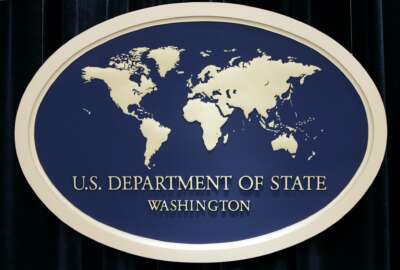
How the State Department uses artists and artwork as part of its worldwide diplomatic effort
The State Department sometimes uses art and artists to spread diplomacy and U.S. culture overseas.
Best listening experience is on Chrome, Firefox or Safari. Subscribe to Federal Drive’s daily audio interviews on Apple Podcasts or PodcastOne.
For the State Department, diplomacy and projecting American values around the world relies on the Foreign Service staff and its ambassadors. But it uses other means to enhance the mission, like art and artists. For more on the Art in Embassies program, Federal Drive with Tom Temin spoke to the acting Director of the State Department’s Bureau of Overseas Building Operations Henry Jardine.
Interview transcript:
Tom Temin: Mr. Jardine, good to have you on.
Henry Jardine: Tom, thank you very much. Enjoy the opportunity to speak a little bit about what we do with our overseas buildings and the art that we put in those buildings.
Tom Temin: And this is more than old master-style paintings of George Washington on the Potomac reproduced and put in every embassy isn’t it?
Henry Jardine: Very much so. What we’re trying to do actually, is really use the embassies as a platform to project more about the United States, project, our art, our culture, and really provide opportunities for people to connect with the U.S. with the US people and our US culture.
Tom Temin: And the implication there is that lots of people in foreign countries visit the U.S. embassy for one purpose or another.
Henry Jardine: Tom, yeah, typically, they do. Often, as you know, many people want to travel to the U.S., although that’s been a big challenge with COVID. But I’m assuming we’ll see people coming again. And we have always had lots of visitors. And so they need visas in many cases, and the place they go to get those visas are the embassies and consulates we have overseas. And when they’re in those facilities, that’s a perfect opportunity to show more about the United States in a very positive light. I think, as we all know, the culture of the United States is one that is out there and is global, and has, appreciation from large audiences. But, we really want to give as much exposure as we can to the art and culture of the United States. And you have an automatic audience when you talk about people coming in for visas.
Tom Temin: And so what is the process by which in a given embassy, the art is chosen? And I guess it’s probably more than simply painted art on a frame on a wall too, isn’t it? So tell us about how the whole Art in Embassies program works in general?
Henry Jardine: Well, you know, we have a wonderful team of curators, registrars and a strong team of people with backgrounds in art. And that office, our embassy office, within my bureau – the Bureau of overseas buildings operations, which is again part of the State Department – that team is very trained, very connected, very knowledgeable of art, a cross section of art, what they typically do is, is when we have a new building that’s being commissioned a new building that’s being constructed overseas, for instance, we are in the process of finishing an embassy in Maputo. Also, we’re preparing a new consulate project for Milan. So a percentage of that project, and these projects are typically hundreds of millions of dollars. So a small percentage of the project is allocated for art. And our art embassies team will take that budget, and then they’ll look at the environment, they’ll look at the building, they’ll look at the- and they’re very much involved in the early designs of the building. And they’ll look at how the building is being designed. They’ll think about what is the cultural touchpoints in that country? What are the things that are distinctive about the art design culture of a particular country? And then what are the things that are comparable in the U.S.? How would our experiences in the U.S. have a link or share some of that relationship? And so the idea is you want to have art that sort of sensitive to the local culture in a way. If, for instance, in a country where you know, the art is expressed through textiles, you may look at an artist in the United States who specializes in textiles, and then use that artwork as a way of having a bit of a dialogue so that when somebody from that country comes in, and they’re getting their visa, they may recognize elements of their local art, but see how it parallels in the U.S. Or, for instance, you know, you there may be something distinctive in the nature and ecology and the environment of that country. And it’ll be manifest in the art there in the embassy. An example is, for instance, in Jakarta, there’s a very beautiful piece of art in the main lobby of that embassy, that is sort of a sculpture almost of various sea life of starfish, shells and other sea life that’s sort of arranged in a very artistic way, colored in a very artistic way that’s there in the lobby of the new embassy in Jakarta that was recently completed just a couple years ago. And so, you know, again, Jakarta is an archipelago it’s very much connected with the sea. But then this brings that element in there. And it has an aesthetic value, but it also has a link with the United States and to the local dynamic. So ready to go on, very much enjoy this this topic because I think it’s a a unique distinctive way we engage in diplomacy that most people just don’t know about.
Tom Temin: Yeah, it really is distinctive, so that people get a sense of their own nation, as interpreted by American artists to some degree, then?
Henry Jardine: Yes, very much. So for instance, in Maputo, one of the kinds of styles of artists – sort of found art, in other words – we’ve been looking at working with a local artist who takes in fact, as a commentary on some of the conflict that had been in that country takes old weapons, old pieces of metal and weld them together to form artwork. We have similar artists here in the United States who do some found art where they take, you know, farming utensils and they weld them together and they create sort of an artistic sculpture. And so you have these parallels between the local artists and the artists in the United States. And you create that dialogue. And so those are the kinds of approaches we try to take. When we think about the art, we want it to be an art that has many dimensions and allows for connections between our two cultures.
Tom Temin: We’re speaking with Henry Jardine. He’s acting director of the Bureau of Overseas Building Operations at the State Department. And how does one get to be an artist employed by the State Department or used by the State Department?
Henry Jardine: Well, I guess you have to be good, in simple terms.
Tom Temin: That’s a good start.
Henry Jardine: Yeah, that’s a good start. It’s very simple. No, but what our team tries to do is they try to look for a sort of up-and-coming artists and it oftentimes, once they’ve identify an artist, they get more famous, just not just because they working for us, but because I think we have a, very good team that has a good eye for the sort of the up-and-coming artists that will, I think get recognition going forward. And so that’s why when we look at opportunities for working with artists, we try to find artists that, you know, show a lot of imagination that are sort of doing cutting edge kinds of approaches in their medium, whether it’s in sculpture, whether it’s in, sort of illustration, paint, textile, pottery, a whole host of different kinds of artistic medium. Looking for artists who, are starting to really make a name for themselves are getting recognized through different exhibitions, or through presidents at different museums or through different, awards, and then use those artists, to be able to, again, reflect on how the United States, and the art has been evolving, make it interesting and dynamic. Similarly, they do work with local artists at times, artists that are also up-and-coming artists that, would be of note. And so that gives us an opportunity really to get artists who are sort of on the upswing, and then you know, help those artists in a way to be able to project more to a global audiences. And we do in addition to the art, that’s what we call a permanent installation that are in the embassies that – or consulates that we’re constructing, we also do sort of temporary exhibits, whenever an ambassador is getting prepared to go overseas, they are allowed the opportunity to do a temporary exhibit. In other words, they will do a specifically curated exhibit for them in particular. And what that allows then an ambassador do is they come in and they consult with our embassy team. And they think about the kinds of themes, images, messages that they want to have is sort of, as I think emblematic of their tenure, typically an ambassador will spend three years in a particular country. And so working with our team, they’ll then look at potential artists that might be interested in collaborating, and oftentimes, we’re fortunate that many artists, will own their work, and so, it’s a good relationship. It’s not just simply us purchasing work, but also artists who are interested in having their work exhibited. And, you know, I think that’s a great benefit to the US taxpayer and the US government is result.
Tom Temin: Sure if there’s an exhibit that is mounted at a particular embassy, that’s a good opportunity for the ambassador there to have foreign nationals, his counterparts or her counterparts come in for an encounter. They have pretext of the art, and it’s just a way to build relationships too I imagine.
Henry Jardine: Very much so. And the other nice thing we often do is we will have the artists go overseas as well. They will travel, with their art at times for these exhibits. And they’ll have dialogues with artists there also with students. And you know, again, one of the things we’re very focused on just as a matter, of course, I think across the US government, when we’re overseas is engaging with an up-and-coming generation of people. They will be the future leaders of countries. And so we want to make sure that the US engagement with that up-and-coming generation is one that’s that’s multi layered and comprehensive. And so, this is just another avenue for having that dialogue. And I think it’s a way that people engage with more. Again, we can go and have very dry policy discussions. But that doesn’t engage a cross section of people in a particular country. This is an entree that I think really helps us.
Tom Temin: And for your own job, overseas building operations, I imagine the art aspect of this is probably a lot more compelling than, say, dealing with a broken air conditioner in Dubai?
Henry Jardine: Well, I can’t say that because I know our facilities manager’s here, would get upset if I said that. But I could understand why one would think that. We have a great team of people. They’re very skilled and talented engineers, and they’re all appreciated. But I think on the art side, obviously the aesthetics interest, and it is a fascinating area, and it’s one that I don’t think typically gets as much exposure. But yeah, you’re right, it can be quite engaging.
Tom Temin: Henry Jardine is acting director of the Bureau of Overseas Building Pperations at the State Department. Thanks so much for joining me.
Henry Jardine: Tom, thank you very much. And yeah, really appreciate the opportunity to talk about something that I don’t think many people are aware of. And I hope folks look into this and read a bit about it. Thank you.
Tom Temin: We’ll post this interview along with a link to more information at FederalNewsNetwork.com/FederalDrive. Subscribe to the FederalDrive at Apple Podcasts or wherever you get your shows.
Copyright © 2025 Federal News Network. All rights reserved. This website is not intended for users located within the European Economic Area.
Tom Temin is host of the Federal Drive and has been providing insight on federal technology and management issues for more than 30 years.
Follow @tteminWFED
Related Stories





